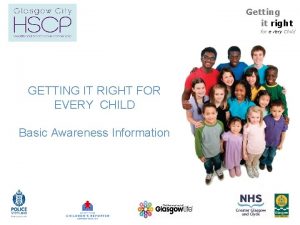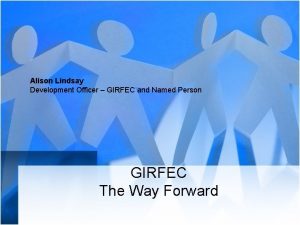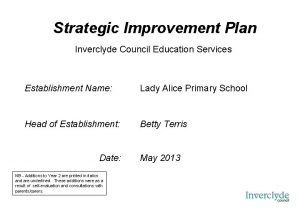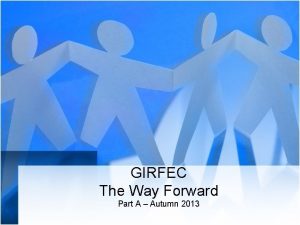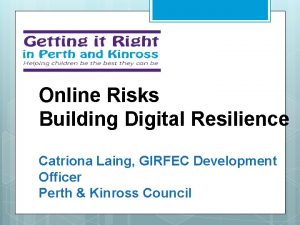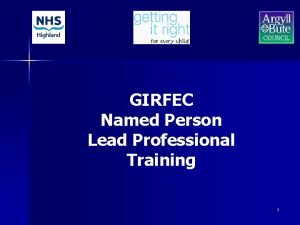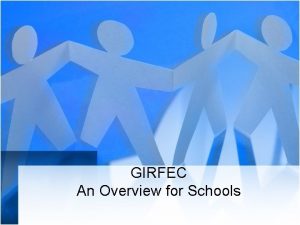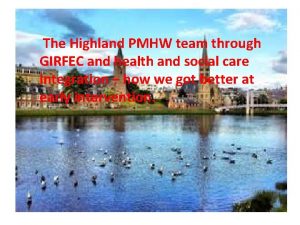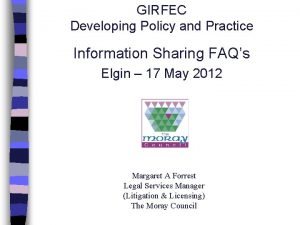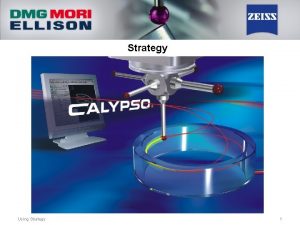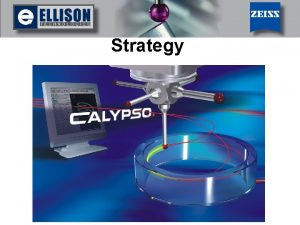The Inverclyde GIRFEC Pathways GIRFEC Pathways Strategy Group


































- Slides: 34

The Inverclyde GIRFEC Pathways

GIRFEC Pathways Strategy Group • Angela Edwards/Ruth Binks (Heads of Service) • Sheena Beaton, Norman Greenshields, Linda Wilkie (QIO Team) • Kate Watson, Margaret Nash, Paula Dudgeon, Laurence Reilly, Michelle Keith (Ed Psych Services) • Liz Ruddy, Graeme Marshall, Simone Mc. Credie (Primary Ed. ) • Alan Dick, Gillian Macartney, Fiona Craig (Secondary Ed. )

Home Page Pathways Definitions Wellbeing Assessment Pathway Examples Named Person/Lead Professional Definition Wellbeing Assessment Example My World Triangle Assessment Example Single Agency Led Plan Example

The Inverclyde GIRFEC Pathways Enhanced Collaborative Enhanced Universal

The Inverclyde GIRFEC Pathways The purpose of the Inverclyde GIRFEC Pathways policy is to provide a model for the Named Person (in some cases, in partnership with the Lead Professional) to assist the practical process of ensuring Wellbeing for every child. It is the process by which we Get It Right For Every Child where there is a clear understanding that the ‘It’ represents the service required to support a Child’s Wellbeing

The Inverclyde GIRFEC Pathways There are four Inverclyde GIRFEC Pathways: Universal, Enhanced Universal, Collaborative and Enhanced Collaborative. All children and young people in Inverclyde are on a GIRFEC Pathway at all times. There is a presumption that children will follow the Universal Pathway unless an unmet need is impacting on an individual’s Wellbeing Outcomes.

The Inverclyde GIRFEC Pathways The voice of the Child and their Family is a central feature of The GIRFEC Pathways. • Culture and Ethos: Services should work to create the type of relationships which ensure children and their families feel confident about raising wellbeing concerns to someone within the Named Person Service and in engaging in the process of addressing these concerns. • Informed Consent: Services should establish an agreed standard and format to gain consent from children and their families, when it is in the best interest of the child, to share information with another professional.

The Inverclyde GIRFEC Pathways • Active Participation: Professional are expected to encourage the participation of children and their families at every step along the GIRFEC Pathways. Indeed, the Inverclyde Wellbeing Assessment tools specifically require the views of the child and parent to be formally recorded as part of the process. • Understanding the Child’s Point of View: Professionals should use age/stage appropriate resources, such as Nurturing Me, to help determine the child’s views of their network of support and the process of assessment, planning and review.

Universal Pathway The Universal Pathway encompasses the Cf. E entitlement of personal support for all pupils. The promotion of Wellbeing is embedded in the culture and ethos of the establishment and is evident in its policies, systems and practice. The Universal Service is the generic ways in which establishment staff meet the wide continuum of wellbeing needs of children through the normal day-to-day running of the school. It is a dynamic, evolving provision, responsive to strategic improvement and inevitable changes in resources.

Enhanced Universal Pathway The Enhanced Universal Pathway is followed when a child is assessed as needing something different from, or significantly more of, what is normally provided within the Universal Service. When the unmet needs of a child are deemed, in the judgement of the Named Person, to be impacting on their wellbeing outcomes, a single agency wellbeing assessment may be initiated to analyse those unmet needs. If this assessment informs the development of a single agency led plan, outcomes and interventions are agreed within the scope of the Enhanced Service.

Collaborative Pathway The Collaborative Pathway is followed when a child is assessed with needs that cannot be met by the Single Agency Led Plan alone. When the unmet needs of a child are deemed, in the judgement of the Named Person, to be impacting on their wellbeing outcomes, a My World Triangle Assessment may be initiated to analyse those unmet needs. If this assessment informs the development of a multi-agency plan, outcomes and interventions requiring the collaboration of more than one service are agreed. The most appropriate Lead Professional is identified to oversee this plan.

Enhanced Collaborative Pathway The Enhanced Collaborative Pathway is followed when a Statutory Child’s Plan is required to ensure the outcomes are met as a result of the interventions which are delivered.

The Inverclyde GIRFEC Pathways There are features of the Universal Pathway which are consistent across all Inverclyde Educational Establishments… …and there are features of the Universal Pathway which may be specific to a particular Educational Establishment as a result of school policy, experience or expertise. This means that Transitions are critical events on a child or young person’s Pathway to ensure Wellbeing Assessments and Plans are effective in maintaining Wellbeing.

The Inverclyde GIRFEC Pathways Each Educational Establishment will have ways in which they promote Wellbeing within their Universal Service and identify and record when a child’s Wellbeing is being affected by unmet needs. The way in which this is identified, recorded and passed to the Named Person may differ from establishment to establishment, but the Single and Multi Agency Wellbeing Assessment is standardised across Inverclyde.

The Inverclyde GIRFEC Pathways Most of the time, a concern about a child’s wellbeing is responded to within the Universal Pathway. The other Inverclyde GIRFEC pathways exist to allow a consistent model for achieving positive wellbeing outcomes when concerns about a child’s wellbeing are becoming increasingly complex, immediate, intense or require the intervention of other agencies.

Inverclyde GIRFEC Pathways Example 1: in which a Wellbeing Assessment helps to establish the features of the Universal Service a child requires. Enhanced Collaborative Enhanced Universal Wellbeing Concern passed to Named Person Single Agency Wellbeing Assessment Continue Universal Personal Support

Inverclyde GIRFEC Pathways Example 2 : in which a Wellbeing Assessment helps to establish the need for a Single Agency Led Plan. Enhanced Collaborative Establish Single Agency led plan Enhanced Universal Wellbeing Concern passed to Named Person Single Agency Wellbeing Assessment Review Single Agency Plan

Inverclyde GIRFEC Pathways Example 3 : in which a Wellbeing Assessment helps to establish the need for Multi Agency Child’s Plan. Enhanced Collaborative Create Multi Agency Plan Collaborative Establish Single Agency led plan Enhanced Universal Wellbeing Concern passed to Named Person Single Agency Wellbeing Assessment Review Single Agency led plan My World Triangle Assessment Review Multi Agency Plan

Inverclyde GIRFEC Pathways Example 4: in which a Wellbeing Assessment helps to establish the need for further assessment leading to a Multi Agency Plan. Enhanced Collaborative Create Multi Agency Plan Collaborative Enhanced Universal Wellbeing Concern passed to Named Person Single Agency Wellbeing Assessment Continue Universal Personal Support Wellbeing Concern passed to Named Person Single Agency Wellbeing Assessment My World Triangle Assessment Review Multi Agency Plan

Inverclyde GIRFEC Pathways Enhanced Collaborative Enhanced Universal

Inverclyde GIRFEC Pathways Enhanced Collaborative Enhanced Universal

Inverclyde GIRFEC Pathways Enhanced Collaborative Enhanced Universal

Inverclyde GIRFEC Pathways Enhanced Collaborative Enhanced Universal

Key Features Named Person The professional within one of the universal services of maternity, public health, primary or secondary education who is responsible for children and young people’s wellbeing at different stages of their lives What I Think Tool Is a tool which supports professionals to encourage children and young people to express and record their own views about wellbeing, what help they might need and what they would like to change Wellbeing Wheel Represents the eight indicators of wellbeing which are the desired outcomes for every child in Scotland. Each aspect of children and young people’s wellbeing should be considered if professionals have any concern Discussion with child/young person Children and young people should be consistently involved in the decisions which affect their lives and professionals are expected to encourage participation at every stage in any process of assessment, planning and review Resilience Matrix The tool which is used to analyse all the available information to identify the priority issues in a child or young person’s life and what needs to change. It allows the balance between adversity and protective factors and between resilience and vulnerability to be identified Informed Consent An agreed standard and format used to gain permission from children and families when it is in the best interest of a child or young person to share information with another professional Single Agency led plan This plan is used within one agency and follows on from any Single Agency Assessments. It identifies the desired outcomes or positive changes needed to a child’s wellbeing and the actions necessary to achieve them. The Single Agency Plan will also contain timescales and who is responsible for achieving them The Integrated Assessment A format used when agencies need to integrate their working practice to develop a child’s wellbeing. It builds from Single Agency Assessments and Plans using the My World Triangle and Resilience Matrix The Child/Young Person’s Network of Support This is the term used to describe the group of practitioners who are contributing to improving a child/young person’s wellbeing at any given time. It could be a large group from different agencies or two or more practitioners from the same agency Multi Agency Plan The multi agency plan is used when agencies need to integrate their working practice to develop a child or young person’s wellbeing. It follows on from the Integrated Assessment and specifics the desired outcomes or positive changes and the actions necessary to achieve them. It details exactly what will be done by whom and by when to develop a child or young person’s wellbeing Single Agency Chronology An agreed format used within one agency to provide a summary of positive and negative significant events for the child/young person. This tool helps to identify patterns and trends in children and young people’s lives and will contribute to ongoing assessment, planning and review My World Triangle The My World Triangle Assessment provides a common structure to think about the child’s whole world when one agency needs a detailed picture of a child/young person’s life. It is used to gather and structure relevant information into a mental map of all the strengths and pressures affecting a child and family to identify the most appropriate response A Request for Assistance An agreed format to ask for help for a child/young person no matter what they need from health, education, social work, housing, adult services or the voluntary sector. The aim is to replace all existing referral forms we currently use with one standard format Lead Professional The professional who agrees to coordinate and review the Child’s Plan when more than one agency is working together Integrated Chronology An agreed format which brings together information from all Single Agency Chronologies into one single document, providing a summary of positive and negative significant events. It can be regularly updated and discussed as part of ongoing assessment and planning to make sure that everything possible is being done to develop the child/young person’s wellbeing

Named Person The professional identified within one of the universal services of public health, primary or secondary education whose service is responsible for children and young people’s wellbeing at different stages of their lives

Lead Professional The professional who agrees to coordinate and review the Child’s Plan when more than one agency is working together

Wellbeing Assessment This is the format for recording a Single Agency Wellbeing Assessment. This is completed by the Named Person or someone delegated to do so by the Named Person. It might be completed during a single meeting or over a period of time as information is gathered and checked for reliability.

My World Triangle Assessment My World Triangle The My World Triangle Assessment provides a common structure to think about the child’s whole world when one agency needs a detailed picture of a child/young person’s life. It is used to gather and structure relevant information into a mental map of all the strengths and pressures affecting a child and family to identify the most appropriate response

Action Plan

Single Agency led plan This plan is used within one agency and follows on from any Single Agency Assessments. It identifies the desired outcomes or positive changes needed to a child’s wellbeing and the actions necessary to achieve them. The Single Agency Plan will also contain timescales and who is responsible for achieving them

Multi Agency Plan The multi agency plan is used when agencies need to integrate their working practice to develop a child or young person’s wellbeing. It follows on from the Integrated Assessment and specifics the desired outcomes or positive changes and the actions necessary to achieve them. It details exactly what will be done by whom and by when to develop a child or young person’s wellbeing

Single Agency Chronology An agreed format used within one agency to provide a summary of positive and negative significant events for the child/young person. This tool helps to identify patterns and trends in children and young people’s lives and will contribute to ongoing assessment, planning and review

Integrated Chronology An agreed format which brings together information from all Single Agency Chronologies into one single document, providing a summary of positive and negative significant events. It can be regularly updated and discussed as part of ongoing assessment and planning to make sure that everything possible is being done to develop the child/young person’s wellbeing

A Request for Assistance An agreed format to ask for help for a child/young person no matter what they need from health, education, social work, housing, adult services or the voluntary sector. The aim is to replace all existing referral forms we currently use with one standard format
 Ruth binks inverclyde council
Ruth binks inverclyde council Girfec national practice model
Girfec national practice model Girfec 5 key questions
Girfec 5 key questions Hát kết hợp bộ gõ cơ thể
Hát kết hợp bộ gõ cơ thể Frameset trong html5
Frameset trong html5 Bổ thể
Bổ thể Tỉ lệ cơ thể trẻ em
Tỉ lệ cơ thể trẻ em Gấu đi như thế nào
Gấu đi như thế nào Tư thế worms-breton
Tư thế worms-breton Alleluia hat len nguoi oi
Alleluia hat len nguoi oi Các môn thể thao bắt đầu bằng từ đua
Các môn thể thao bắt đầu bằng từ đua Thế nào là hệ số cao nhất
Thế nào là hệ số cao nhất Các châu lục và đại dương trên thế giới
Các châu lục và đại dương trên thế giới Công của trọng lực
Công của trọng lực Trời xanh đây là của chúng ta thể thơ
Trời xanh đây là của chúng ta thể thơ Cách giải mật thư tọa độ
Cách giải mật thư tọa độ Làm thế nào để 102-1=99
Làm thế nào để 102-1=99 Phản ứng thế ankan
Phản ứng thế ankan Các châu lục và đại dương trên thế giới
Các châu lục và đại dương trên thế giới Thơ thất ngôn tứ tuyệt đường luật
Thơ thất ngôn tứ tuyệt đường luật Quá trình desamine hóa có thể tạo ra
Quá trình desamine hóa có thể tạo ra Một số thể thơ truyền thống
Một số thể thơ truyền thống Cái miệng xinh xinh thế chỉ nói điều hay thôi
Cái miệng xinh xinh thế chỉ nói điều hay thôi Vẽ hình chiếu vuông góc của vật thể sau
Vẽ hình chiếu vuông góc của vật thể sau Thế nào là sự mỏi cơ
Thế nào là sự mỏi cơ đặc điểm cơ thể của người tối cổ
đặc điểm cơ thể của người tối cổ Thế nào là giọng cùng tên
Thế nào là giọng cùng tên Vẽ hình chiếu đứng bằng cạnh của vật thể
Vẽ hình chiếu đứng bằng cạnh của vật thể Fecboak
Fecboak Thẻ vin
Thẻ vin đại từ thay thế
đại từ thay thế điện thế nghỉ
điện thế nghỉ Tư thế ngồi viết
Tư thế ngồi viết Diễn thế sinh thái là
Diễn thế sinh thái là Các loại đột biến cấu trúc nhiễm sắc thể
Các loại đột biến cấu trúc nhiễm sắc thể

